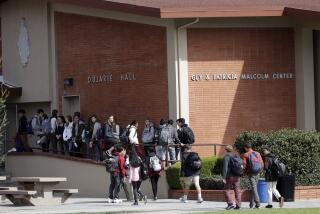EL SERENO : Teen Court Judges Wilson High Peers
- Share via
Michelle R. sat in a chair facing six teen-agers, quietly answering their questions before they decided her fate.
The 13-year-old was caught shoplifting cassettes at a K mart and decided to allow a jury of Wilson High School students--her peers--to hand down her punishment. The students are enrolled in the school’s justice and law magnet program and, under the Teen Court program, received training on juvenile offenses and sentencing.
Started in April by Jaime Corral, presiding judge of the Northeast Juvenile Justice Center, the Teen Court at Wilson High brings area juvenile offenders to be tried before the students twice a month. This semester, the students decided 15 cases involving vandalism, graffiti, theft and assault. Probation officers follow up on the cases.
Though Wilson is the only school in the Teen Court program, Garfield, Lincoln and Roosevelt are looking into joining next year, Corral said.
Several cities have incorporated the diversion program into their juvenile justice systems, said probation officer Phillip J. Egans, who decides which juveniles may be handled through the Teen Court. The teen-agers and their parents must agree to appear in Teen Court. Otherwise, they will go through the juvenile justice center.
“The kids that are involved are borderline kids,” Egans said. “Peer pressure is great, either positive or negative, and this way they get a chance to see what we do.”
The Wilson students said they take their eight or nine cases a month seriously and try to be conscientious in handing down a sentence to fit the crime.
“It’s a lot better than being judged (in the regular court),” said juror Omar Salgado, 17. “We see it in a different way. I’ve had friends who have been caught shoplifting, and I know that they’re not all bad people.”
Offenders often say they believe they have been treated fairly by the teen-agers, Corral said, even though many of the sentences handed down are tougher than what they might have received in his court.
“(The students) can’t recommend incarceration or a payment of a fine, but in one of their cases, they recommended 400 hours of community service and that’s unheard of. I wouldn’t have recommended that,” Corral said.
The students say the job is more difficult than just deciding guilt or innocence because most of the defendants admit their guilt. The jurors ask questions about trouble in school, parent involvement and whether the defendant has a history of getting into trouble.
Michelle R., who said she had gone to K mart with two friends who took off when she was caught, was sentenced to six months’ probation and ordered to write an apology to the store manager and deliver it with an oral apology. She also had to write a 1,000-word essay on why stealing is wrong.
The decision, she said, was “fair” and left her relieved.
“Because they’re my age, they know what it’s like,” she said. “I was expecting community service.”
Antonio G. was found innocent of sexual battery in a case where he admitted to grabbing a woman’s buttocks. The student jurors instead found him guilty of simple battery and ordered him to undergo counseling to focus on his anger and to write a letter of apology to the victim.
Student Howard Perez, 17, said the jurors considered also sentencing Antonio G. to community service but decided that counseling would give him the chance to address his problems.
“I thought, ‘How can he have community service if he can’t cooperate with other people?’ ” Perez said. “I think (his temper) would have progressed because that comes from yourself and it runs in the family. His mother said he has the same temper as she does. It won’t go away by itself.”
More to Read
Sign up for Essential California
The most important California stories and recommendations in your inbox every morning.
You may occasionally receive promotional content from the Los Angeles Times.










